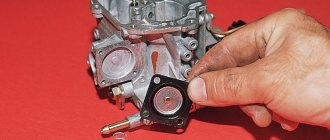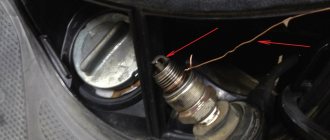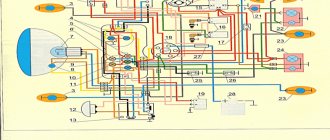01/18/2022 16 101 Consultation with a specialist
Author: Ivan Baranov
The fuel gauge always shows a full tank. I changed the float and it still shows a full tank. I rang the wiring - to no avail. What to do? (Sergey)
Hello, Sergey. Our resource specialist has studied your question and is ready to give a comprehensive answer to it.
[Hide]
Scooter gasoline level sensor
The fuel level sensor on the scooter serves as an indicator for tracking the amount of gasoline in the tank.
Its performance and ability to show the correct amount of gasoline in the tank is a very important element for comfortable operation of the scooter. How to check the functionality of the fuel level indicator and determine the correctness of the sensor readings - more on this later. One of the popular Chinese scooters will act as a test subject, since it is Chinese scooters that often suffer from similar diseases. The test parameters indicated below can be attributed specifically to Chinese devices and no analogies were made with Japanese models.
There are several ways to determine the performance of the fuel level indicator. Let's consider the simplest one. It will not show the accuracy of the sensor readings, but will determine the operating status of the indicator. In our case, it is enough to lift the seat and get to the main harness. We find the main wiring harness of the scooter and disconnect the connector of the yellow-black and black-white wires coming from the fuel level sensor. After this, turn on the scooter’s ignition, the fuel indicator arrow should show “full tank” or the value “F”. Let's move on to checking the accuracy of the fuel level values on the scooter. To check the values in the extreme positions of the indicator, we connect a resistance between the yellow-black and black-white wires with a value of 90 Ohms. If the arrow points to an empty tank (“E”), it is obvious that the sensor is showing the correct values. As the resistance gradually decreases to 10 ohms, you can observe how the fuel level needle gradually rises to a full tank (“F”). If the readings are different from the above, it is obvious that the fuel indicator on the scooter is faulty.
Now let's check the fuel level sensor. To do this, we disconnect those wires that come from the level sensor and check the resistance on them one by one. With a full tank (“F”), the resistance value should be at 33 Ohms. When half-filled, the resistance values are around 200 Ohms, and an empty tank (“E”) will show about 566 Ohms. This relationship between the position of the fuel level indicator float on a Chinese scooter and the resistance indicates the accuracy of the readings. If the obtained values differ significantly, we can conclude that the sensor is faulty. ATTENTION. EACH SCOOTER HAS ITS OWN CABLES AND TANK CAPACITY. BE CAREFUL. CONTACT THE SPECIALISTS.
Source
Scooter fuel level sensor - checking the performance and accuracy of readings
The fuel level sensor on the scooter serves as an indicator for tracking the amount of gasoline in the tank.
Its performance and ability to show the correct amount of gasoline in the tank is a very important element for comfortable operation of the scooter. How to check the functionality of the fuel level indicator and determine the correctness of the sensor readings - more on this later. One of the popular Chinese scooters will act as a test subject, since it is Chinese scooters that often suffer from similar diseases. The test parameters indicated below can be attributed specifically to Chinese devices and no analogies were made with Japanese models.
- There are several ways to determine the performance of the fuel level indicator. Let's consider the simplest one. It will not show the accuracy of the sensor readings, but will determine the operating status of the indicator. In our case, it is enough to lift the seat and get to the main harness. We find the main wiring harness of the scooter and disconnect the connector of the yellow-black and black-white wires coming from the fuel level sensor. After this, turn on the scooter’s ignition, the fuel indicator arrow should show “full tank” or the value “F”.
- Let's move on to checking the accuracy of the fuel level values on the scooter. To check the values in the extreme positions of the indicator, we connect a resistance between the yellow-black and black-white wires with a value of 90 Ohms. If the arrow points to an empty tank (“E”), it is obvious that the sensor is showing the correct values. As the resistance gradually decreases to 10 ohms, you can observe how the fuel level needle gradually rises to a full tank (“F”).
If the readings are different from the above, it is obvious that the fuel indicator on the scooter is faulty.
Now let's check the fuel level sensor. To do this, we disconnect those wires that come from the level sensor and check the resistance on them one by one. With a full tank (“F”), the resistance value should be at 33 Ohms. When half-filled, the resistance values are around 200 Ohms, and an empty tank (“E”) will show about 566 Ohms. This relationship between the position of the fuel level indicator float on a Chinese scooter and the resistance indicates the accuracy of the readings. If the obtained values differ significantly, we can conclude that the sensor is faulty.
You can also read other articles on the topic:
Source
Preparation for removing or replacing the fuel sensor on the VAZ-2110 and Lada Kalina
Replacing the FLS on a VAZ-2110 and Lada Kalina is possible only after preliminary dismantling of the fuel module. It is advisable that during work the tank is filled with gasoline to no more than half.
The procedure for preparatory operations for the VAZ-2110 and Lada Kalina is the same:
- Remove the lower part of the rear seat.
- We bend the protective mat and sound insulation of the body above the fuel module hatch.
- We clean the hatch cover and the body around it from dust and debris.
- Using a Phillips screwdriver, unscrew the 4 screws securing the hatch cover to the body.
- Remove the cover.
- We remove accumulated dirt and dust from the fuel module.
- Having released the connector block lock, disconnect the connector with wires from the fuel module body.
- We relieve the gasoline pressure in the fuel line - turn on the starter for 10–15 seconds so that it rotates the crankshaft during this time (if the engine starts, then wait until the gasoline from the fuel line is exhausted and the engine stalls itself), and then turn off the ignition.
- We disconnect the “ground” of the car with a button or by disconnecting the battery terminal.
During subsequent replacement operations, keep in mind that some gasoline remains in the fuel line after the pressure is released.
Scooter fuel level sensor - checking the performance and accuracy of readings
How to check the functionality of the fuel level indicator and determine the correctness of the sensor readings - more on this later. One of the popular Chinese scooters will act as a test subject, since it is Chinese scooters that often suffer from similar diseases. The test parameters indicated below can be attributed specifically to Chinese devices and no analogies were made with Japanese models.
1) There are several ways to determine the performance of the fuel level indicator. Let's consider the simplest one. It will not show the accuracy of the sensor readings, but will determine the operating status of the indicator. In our case, it is enough to lift the seat and get to the main harness. We find the main wiring harness of the scooter and disconnect the connector of the yellow-black and black-white wires coming from the fuel level sensor. After this, turn on the scooter’s ignition, the fuel indicator arrow should show “full tank” or the value “F”. 2) Let’s move on to checking the accuracy of the fuel level values on the scooter. To check the values in the extreme positions of the indicator, we connect a resistance between the yellow-black and black-white wires with a value of 90 Ohms. If the arrow points to an empty tank (“E”), it is obvious that the sensor is showing the correct values. As the resistance gradually decreases to 10 ohms, you can observe how the fuel level needle gradually rises to a full tank (“F”). If the readings are different from the above, it is obvious that the fuel indicator on the scooter is faulty.
Now let's check the fuel level sensor. To do this, we disconnect those wires that come from the level sensor and check the resistance on them one by one. With a full tank (“F”), the resistance value should be at 33 Ohms. When half-filled, the resistance values are around 200 Ohms, and an empty tank (“E”) will show about 566 Ohms. This relationship between the position of the fuel level indicator float on a Chinese scooter and the resistance indicates the accuracy of the readings. If the obtained values differ significantly, we can conclude that the sensor is faulty.
Rheostat fuel level sensor
The operating principle of such a sensor is based on bimetallic strips, which move the indicator needle on the instrument panel. The position of the strip depends on the resistance created in the sensor circuit.
A float with a special lever is installed in the car’s gas tank. As the fuel in the tank increases, the resistance decreases, which means the current increases, which heats the strip and it moves the indicator needle.
When the fuel level decreases, the float lowers and uses a lever to reduce the voltage in the circuit. Thus, the current decreases, and the bimetallic strip moves the indicator needle to a different position, corresponding to the fuel level in the tank.
To put it simply, if the circuit breaks, the sensor stops working, and will always indicate that the tank is empty, and if there is a short circuit in the rheostat circuit, it will indicate that the tank is completely filled with gasoline.
There are a number of sensors in which the resistance changes quite the opposite. Accordingly, the readings will be different.
Video: If the fuel level sensor in the scooter does not work
Good afternoon, tell me that the fuel sensor may be frozen, the needle constantly shows the same thing, regardless of how full the tank is. But before you begin direct replacement or repair work, you need to know where the low fuel level sensor is located, how to remove and repair it. It's easier to do this on a scooter by simply taking out the float. Game channel my page VK My group VK ...
Types of FLS and their operating principles
Popular FLS designs: lever, tubular and electronic. The principle of operation is the same for all. The controller reads the position of the float and transmits the information to the indicator. The accuracy and reliability of operation depends on the design of the equipment.
Lever
Consists of a float, a movable connecting lever and a potentiometer (slider with resistor plates).
When the tank is full, the float is located at the top level. It is connected through a lever to a potentiometer. The latter, through the indicator, with the on-board electrical network. The resistance is 7 Ohms, the filling is reflected in the readings of the device on the panel.
As gasoline is burned, the level drops. The float goes down. The slider connected to it moves along the resistor plates and increases the resistance of the potentiometer, up to a maximum of 230-240 Ohms. When it reaches this value, the indicator shows that the tank is empty.
The design is very reliable. The only drawback is related to the wear of parts, which reduces accuracy.
Tubular
The design includes a float, a hollow tube and a contact group. The sensor works similarly to the previous one, but there are design differences. The float has slip rings. The housing contains a resistive wire and a guide post. To connect the control, a mounting flange is provided.
Gasoline enters the housing from below. When the tank is full, the float is located at the top. At this point, the minimum section of the contact wire is connected to it, the resistance is the least. As fuel is consumed, the float lowers and resistance increases. At the bottom it will be maximum.
The advantage of the system is that the float is located in a limited space. The vibrations of the machine are smoothed out, and the readings are much more accurate than those of a lever circuit. But there are installation restrictions.
Electronic
This is a modern model in which the parts do not come into contact with fuel. The reading node is connected to the lever through a magnetic field. The measurement error is no more than 1%. Such devices are used when the car is refueled with gasoline based on methanol, ethanol or biodiesel. Other designs are ineffective in such cases.
The sensor's actuator unit is located in a sealed housing. Only the lever and the magnetic float come into contact with the fuel. The height of the float is measured by magnetic field pulses. Changes are recorded along established intervals. Their passage changes the amplitude of the return signal. The indicator updates the readings after the sensor passes the next mark.
Fuel level sensor does not work
The FLS, like any other elements of the car, can systematically fail, resulting in the need for repair work. Now we will take a closer look at the most common causes of this phenomenon:
If the FLS readings are constantly changing (“jumping”), it is possible that the contact tracks on the board are worn out, which are erased under the influence of time as a result of the device’s slider constantly moving along them. If the worn area is not large, try bending the slider so that it is located above the worn area; however, if the worn area is large, the problem can only be solved by replacing the sensor.
When the engine is running and the ignition is on, the indicator arrow remains stationary. As a rule, the reason lies in damage to the connecting wires, oxidation of their tips, a malfunction of the pointer receiver or a blown fuse.
- If the fuel level indicator needle constantly drops to zero and also twitches, you should check the current collector; it is probably not touching the sensor resistor enough, or the winding of the resistor has broken.
- In addition, the warning lamp about the minimum fuel level in the tank may stop working altogether or work incorrectly, intermittently. In this case, most likely the problem lies in the resistor and you may have to replace it.
The most common problem with potentiometric sensors is their rapid wear, as well as oxidation of the tracks, which determines the appearance of the problems described above.
Adjusting the fuel level in the scooter carburetor
For the carburetor to operate correctly, it is necessary that the gasoline level in the float chamber is adjusted correctly. If there is too much gasoline, the carburetor will excessively enrich the working mixture, which will cause increased fuel consumption and contamination of the cylinder and exhaust with carbon deposits. If there is little gasoline, then a lean mixture will lead to engine overheating and loss of power.
To check the fuel level in the float chamber, with the engine running, you need to move the drain tube (it is transparent) upward and use a slotted screwdriver to unscrew the drain screw. After a couple of seconds, gasoline will fill the tube and you will see its border. In a normal case, the level should be approximately where the edge connecting the float chamber cover to the carburetor body is. In the photo below you can see that the level is above the edge and should be lowered.
To adjust the fuel level, you need to disassemble the carburetor. The fuel level is adjusted by bending the float blade on which the shut-off needle hangs. If we bend the petal slightly upward, we will raise the fuel level, and if downward, we will lower it. The photo shows what position of the float we are talking about (in the working position it is turned vertically the other way around).
In a working carburetor, the installed float should be parallel to the edge. But if the needle or its seat is worn out, the float should protrude slightly with its free edge (opposite to the axis) upward.
Please note: This article and the images in it are subject to copyright. Partial or complete reproduction on other resources without permission is prohibited.
Video: Repair of the fuel sensor Vento Sunny scooter
Fuel level sensor malfunctions
Externally, malfunctions of the fuel level sensor manifest themselves in one of the following situations:
If you have similar problems, it means that the fuel level sensor is not working, but if the needle movement does not drop to zero, and the minimum residue signal lamp does not light up or, on the contrary, lights up even when the tank is full, then this indicates a malfunction of the instrument panel itself.
On cars controlled by an ECU, you can find out about the presence of problems with the FLS by the error codes recorded in the RAM block; to do this, just connect a diagnostic scanner to read the memory and check the parameters of the sensors of various systems.
Fuel level sensor errors
The numbers of the main errors that correspond to malfunctions of the fuel level sensor:
- P0460 - “FLS electrical circuit malfunction.” In practice, this means damage or breakage of the power and/or signal wire. Often this is simply a deterioration of contacts due to their oxidation.
- P0461 - “Signal level out of acceptable limits.” An error is generated if the signal from the fuel level sensor is too weak or too strong. This may also be accompanied by interruptions in the fuel supply to the engine, and as a result, a decrease in its power up to a complete stop.
- P0462 - “Low signal level in the FLS circuit.” Usually the error is formed as a result of corrosion of contacts, open ground circuit, short circuit in the circuit, damage to the fuel tank (fuel leak).
- P0463 - “High signal level in the FLS circuit.” As a rule, the error is formed as a result of damage to either the fuel level sensor itself or its float. There are known cases when it occurred due to the fuel tank rusting.
- P0464 - “Unreliable contact in the FLS circuit.” The error is formed as a result of damage to the insulation on the wiring, oxidation of the contacts, interruptions in the transmission of the signal from the sensor to the electronic control unit.
Main malfunctions in the sensor operation
If the sensor does not display the fuel level correctly, you can judge that a certain breakdown has occurred and needs to be repaired. Modern sensors that record the fuel level, like all vehicle parts, fail from time to time. In this case, it is necessary to repair the fuel level sensor.
Malfunction in indicators
The main sign of a sensor failure is the display of false data displayed on the pointer. Based on its “behavior,” certain conclusions can be drawn regarding the resulting breakdown. Here are the most basic types of breakdowns and their causes:
The indicator is at zero, regardless of the fuel level. The problem is that the float stop is broken. The pointer moves, but still drops to the zero mark. In this case, you need to pay attention to the general condition of the device winding, as well as the reliability of the contact between the sensor and the current collector. Fluctuations in fuel quantity indicators. This malfunction indicates sufficient wear on the contacts. When starting the engine, the fuel gauge does not rise above the zero mark. Such a malfunction is directly related to the electronics of the vehicle
Here it is important to check the wires for possible breaks and the degree of reliability of the connection. It is important to ensure the overall integrity of the fuse. Low fuel light does not light up
This problem is often associated with device failure. The fuel level sensor is lying. In such a situation, it will be necessary to check the float for the level of tightness.
According to modern traffic regulations, operating a car with a faulty indicator is strictly prohibited. Problems that arise with sensors must be eliminated as promptly as possible.
Mechanical and functional malfunction
Along with problems that are expressed in incorrect indicators, sensor failure can manifest itself in the following malfunctions:
- loss of tightness of the built-in float;
- strong bending of the wire holder;
- violation of the general tightness of the housing and the resulting decrease in the level of resistance;
- mechanical break of the variable resistor;
- loss of tightness at the point where the device is attached to the fuel tank.
After the float loses proper tightness, the control device, with a full tank, will indicate an incomplete fuel level. If there is a sufficiently strong loss of tightness, the indicator will immediately show the minimum fuel level. In this case, the actual quantity will not matter. To fix this problem, you will need to remove the sensor and replace the float. If it is not possible to purchase a float, you will need to completely replace the entire device.
Quite often, the sensor fails due to long-term movement over rough or uneven terrain. Repeated impacts on the tank will cause serious damage to the wire holder of the built-in float.
With such bends, the behavior of the indicator will directly depend on where the holder was bent. If the bend is directed upward, the parameters will always be increased, if downward, the parameters will be underestimated. If the breakdown involves such a bend, you just need to straighten the wire holder and give it its original shape.
Often the seal of the sensor housing is broken. This happens after an accident has occurred, as well as after long-term use of low quality fuel. If gasoline gets into the device, it will malfunction and, as a result, cause incorrect sensor readings. These malfunctions can only be eliminated by completely replacing the device.
If the variable resistor breaks, this will cause the sensor to always show a full or completely empty tank. Similar signs can be observed in the process of a break in the signal wire running from the sensor to the display unit. Before removing the sensor, you will need to connect a variable resistor with a resistance level of 100 - 200 Ohms to the car body and to the signal contact. As you rotate the knob, you need to make sure that the sensor readings change. In this case, the malfunction can only be eliminated by completely replacing the device.
The main sign of a complete loss of tightness at the installation site of the device is the appearance of the smell of gasoline in the cabin.
How to check the operation of the sensor
There are many ways to check the performance of the fuel level sensor. One of them is checking the circuit resistance. To do this, connect an ohmmeter to the disconnected contacts and pay attention to the readings. If they deviate from the norm, then you have found the cause of the problem. After this, the fuel level sensor is replaced.
To check the fuel in the tank and assess compliance with the sensor readings, you can use many available tools. Insert a clean dipstick into the tank and check that the tank is full. It is not necessary to have exact readings; in this case, approximate ones will do just fine.
Another way to check is to completely drain the gasoline from the tank and gradually top it up. After each topping up, the resistance value of the sensor is monitored and must be changed.
A similar option is used when removing the sensor from the tank. In this case, you need to change the position of the float lever by hand. Thus, the verification becomes much more accurate.
Non-electrical reasons for sensor malfunction:
- A hole appeared in the float, which caused it to not be properly immersed in gasoline.
- Deformation of the fuel tank, as a result of which it interferes with the normal movement of the float.
- Defects in the float lever. These could be its breaks and kinks.
If the sensor is in perfect order, then the problem must be looked for in the fuel gauge or electrical wiring. To check the wires you need to measure their resistance or simply “ring”.
The operating principles of different types of devices differ.
Operating principle of a lever-type sensor
The float, made in the body of a hollow sealed component, is always located on the surface of the fuel. The device itself can be made of plastic or metal. When fuel is consumed, this component is lowered, and as a result of the action of the lever, the potentiometer slider moves.
The float is in contact with the sectors to which the conductors are connected. The latter are connected to the fuel indicator located in the dashboard. As a result of changing the number of plates connected to the potentiometer circuit, the resistance value changes.
When the fuel tank is full, the slider is set to the extreme position; accordingly, the current flows along the shortest path in the potentiometer. Current transmission is carried out on the sector through a plate located at the edge. Therefore, the resistance value is quite low and is about 7 Ohms. When the fuel is consumed, the slider of the device moves, which contributes to the addition of new plates to the electrical circuit, because of this the resistance value increases. If the tank is half full, the resistance value is about 120 ohms.
The GLONASS monitoring channel Fuel control showed the nuances of using monitoring systems.
If the tank is completely empty, then the plate part of the system is fully activated. Therefore, the resistance parameter will be as high as possible and will be about 330 Ohms. All described resistance values are approximate, since different controller models have certain parameters.
The main advantage of a lever fuel level sensor is the simplicity of the device, due to which such controllers are considered reliable. Their price is low. The main disadvantage of the lever controller is the wear of the contact component. In addition, such sensors have a certain error in values, in particular, we are talking about machines equipped with analog controllers.
Operating principle of a tubular sensor
The operating principle of tubular devices is somewhat different. Fuel passes through the technological hole located in the lower part of the device into the protective pipe. A float is located on the surface of the fuel. As a result of changing the position of the element with an increase or decrease in the volume of fuel, the resistance value changes.
When the vehicle's fuel system reservoir is full, the float is located on top of the safety tube. As the volume of fuel decreases, the float drops and the length of the electrical circuit increases, which leads to an increase in the resistance parameter on the wire section.
If they work, the problem must be looked for in the switch or generator. Somehow I came across a Chinese light bulb that worked like the original, but it burned out after 2 months. Shows how the float in the fuel tank of a Kymco Super 8 scooter works. Repair and cause of a non-working fuel sensor, Peda Enduro B7 motorcycle.
Setting the sender
Once you receive your new fuel gauge kit, you should follow the instructions that apply to your new unit. In general, the installation will involve the following steps
Note that senders are typically not connected devices. The length of the sender arm can be changed according to the dimensions of your fuel tank
This also ensures that the sensor is reading correctly.
First, measure the depth of the fuel tank from the top of the tank, near the sending unit, to the base. This measurement determines the length of the sending unit's float arm. Then cut the transmitter arm and match it to the depth of the tank. A pair of wire cutters usually does the trick, but some require a hacksaw. Once you have cut the float arm to the correct length, secure it with set screws to the flange of the new sender that will be screwed into the top of the tank.
The sending wire comes from the post in the center of the flange. There may also be a ground wire that comes from the second pin at the edge of the flange. Both wires lead to the rear of the fuel gauge. Turn off power to vehicle systems before disconnecting wires. Then disconnect the positive wire and ground wire from the old sending device
Note that if the sensor is grounded directly to the tab on the tank, there may be a missing ground wire. Unscrew the screws that hold the sending unit into the tank and remove it
Next, remove the three wires on the back of the old sensor. One wire goes to the center pin on the tank sending unit, one goes to ground, and the third connects to the 12V source, usually the ignition switch. Remove the fuel level indicator.
Install the new sender by lowering the float into the tank. Be sure to insert a new gasket under the flange, then align the gasket with the holes in the sender and in the tank. Once the gasket is aligned, mark it against the flange as it may rotate while you center the screw holes to match the tank holes. Mark the screw holes in the tank for easy alignment; the flange will cover them and make them difficult to find. Make sure the float arm can move freely and will not stick to the corner of the tank or vertical wall.
Orient the sender block so that the movement of the float is not obstructed. You can test this in advance by holding the sender close to the tank before installing it to see how the float can move freely. Once you know the correct orientation, duplicate it when you place the device in the tank. To minimize confusion, use a marker to show the direction the float arm will move when the screw holes are aligned. Insert new screws and tighten them.
Methods for adjusting and tuning a scooter carburetor
Guys, I have a serious problem with the devices, namely: the fuel level sensor in the gas tank does not work. Does anyone know how to connect, where to solder this sensor? I’ll tell you a little about the wiring of a Chinese scooter, which wire is responsible for what in the dash, where everything goes and... Shows how the float in the fuel tank of a Kymco Super 8 scooter works. The float (black round thing) floats...
Troubleshooting
There are times when the sensor indicates that the tank is always empty or completely full. Moreover, the readings do not change, even if the fuel level is changed.
- The sensor is faulty and needs to be replaced.
- There is a poor contact connection with the body.
- A faulty voltage regulator is supplying incorrect power to the sensor.
- The fuel gauge is faulty.
- There are problems associated with the wiring of the sensor circuit, most often a break.
How is the fuel level gauge checked?
The fuel level gauge can also be checked using several methods. To diagnose its condition, you can remove the sensor from the gas tank and turn on the car’s ignition. Move the float lever in different directions. If the device readings have not changed, it means that it really does not work.
Another way to check is to use a special calibration tester. It is connected instead of the fuel level sensor and changes the resistance of the circuit. If the arrow of the device does not respond, then the pointer needs to be replaced.
If you use a magnetic sensor, you can check the circuit resistance using an ohmmeter. As a rule, the norm for such indicators is considered to be a resistance of 10-15 ohms.
What to do if the fuel level sensor in the tank shows incorrectly, is buggy or lying? After a slight overhaul of my Honda - the battery was changed, the belt, the weights - for some reason the fuel gauge stopped working. Shows how the float in the fuel tank of a Kymco Super 8 scooter works. Brief background. Around 7″000 the fuel indicator began to show heresy. Sometimes it just blinked full...
The fuel level indicator of the Honda DIO 35 ZX behaves somewhat strangely.
#1 Vzhik99
- Participant
- Group: Users
- Posts: 12
- Registration: 20 September 08
After a slight overhaul of my Honda - the battery was changed, the belt, the weights - for some reason the fuel gauge stopped working.
When you turn on the ignition, it doesn’t even twitch. I went and filled up “under the traffic jam” - the arrow showed a full tank and went as far as “F”. I drove a little bit and I saw that it was falling slowly, and after three hundred meters the needle went to zero. Actually, the question is - is the sensor fooling? Or did the float “sink”?
Post edited by Vzhik99: September 20, 2008 - 18:03
Source
Design and operating principle
The sensitive element of the sensor is a rheostat (variable resistor). The sensor output consists of two control wires; ground is connected separately. The level sensor is based on a lever. A small plastic float is installed on one end of it, but the other end is connected to the rheostat, or more precisely, to its slider connected to ground.
The rheostat has two outputs, one of which (the lower one) is not connected to anything, and the upper one produces an analog signal that goes to the fuel level indicator. The control system measures voltage. The indicator is a voltmeter, its full scale is equal to the supply voltage. In simple terms, the indicator measures the voltage, and the level sensor changes its value depending on the amount of fuel in the tank.
The slider is also responsible for turning on the warning lamp. When there are five liters of gasoline left in the tank, the light on the indicator lights up. This is achieved by the fact that the second contact coming from the sensor body is connected to a control lamp. The positive terminal is connected to this lamp, and the negative one goes to the sensor.
What to do if the fuel level sensor in the tank shows incorrectly, is buggy or lying? After a slight overhaul of my Honda - the battery was changed, the belt, the weights - for some reason the fuel gauge stopped working. Shows how the float in the fuel tank of a Kymco Super 8 scooter works. Shows how the float in the fuel tank of a Kymco Super 8 scooter works. Online store in Belarus Group in contact Affiliate...
Features for gasoline and diesel cars
The same DRTs are used for diesel and gasoline engines. Installing the device on gasoline internal combustion engines is considered unprofitable, since gasoline quickly corrodes the internal mechanism of the controller and quickly wears it out. An alternative for a gasoline internal combustion engine can be a contactless sensor or a control system with a CAN bus.
The passage of diesel through the sensor, on the contrary, helps to lubricate the moving parts of the device, which increases its service life. Low-quality diesel fuel with a high content of paraffins and additives can reduce performance. The internal elements of the structure become clogged and incorrect signal transmission occurs. On diesel fuel lines, the DRT is systematically removed and cleaned.











